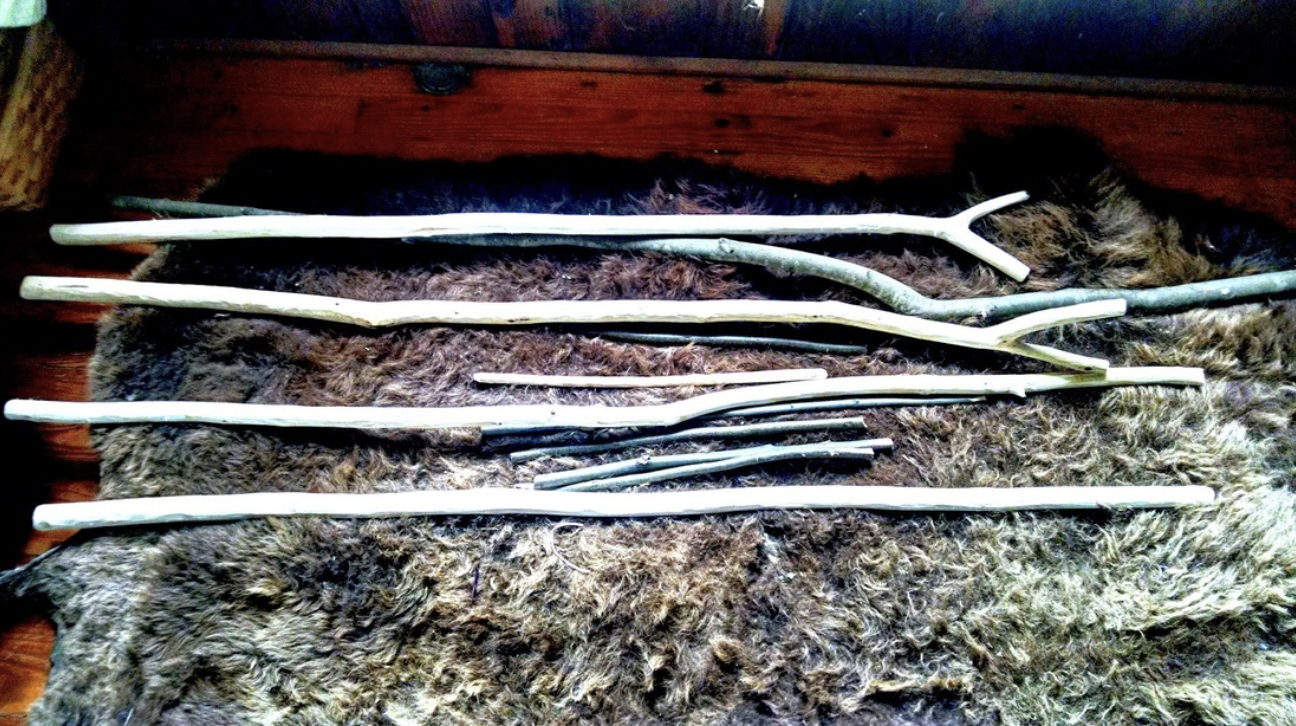The Folkloric Uses of Wood Part II: Apple
There are few trees as loved by the world as the Apple. Known for its lovely fruit, it's wood is seldom mentioned in folklore. While we could write a whole encyclopedia on the folklore, medicinal, edible and magical uses of the Apple's fruit, I am going to condense it down to the basics.
In Europe and Asia, the thorny Crabapple (Malus Sylvestris), was widely distributed since Neolithic times. It is Britain's only native apple. By the time of Pliny, it was noted that there were 22 known varieties of apples. Today we have well over 2,000 worldwide. I always find it interesting to note that wild apples had thorns, and only through selection by humans did they become the much more agreeable tree we know today. Yet, like it's cousins the Blackthorn and Hawthorne, our apples were once armed in the way of the trees of the Fae.
The apple appears in folklore from all over the world, most notably, as the fruit that caused the doom of all humankind. This, however, is unlikely, for Apples were still unknown in that part of the world at the time. It is worth noting as well that the tendency to call all unknown or foreign fruits "apples" until the 17th century has made it difficult to ascertain exactly what fruit or plant is being referred to in history.
In antiquity, apples represented many things to different cultures, but love, immortality and marriage were just a few of the big ones. As Christianity flowed over Europe, the apple transformed from a fruit of love, into a fruit of the flesh, a fruit of sin. This may be why the Latin name for apple is Malus, or "bad". It may also be why this tree went from the fruit of Venus, in Greece to become the tree of witches. Apple trees also are one of the favored hosts for the parasitic Mistletoe so sacred to the Druids, further binding the shining red fruits to devlish activities and foretelling love.
Despite this, many rural folks in the British Isle still sung songs praising apple trees and from Samhain to Yuletide poured libations of cider onto the roots of the dormant trees, hoping to call forth an abundant harvest the next year. There are many different songs from different regions, but here is my favorite that I sing each year:
Across the sea in America, Johnny Appleseed, who was indeed a real human named John Chapman, spread the introduced apple trees to large parts of Pennsylvania, Ontario, Ohio, Indiana, and Illinois, as well as the northern counties of present-day West Virginia. He was a traveling preacher of the Christian mystic tradition known as Swedenborgian of The New Church, (the same tradition William Blake once followed), who left behind him Apple seeds wherever he wandered. ( It's pretty fascinating and worth taking a look at if you are interested in mystic Christian traditions). There is much to say about him as a person and folk figure, but we will just note his role in propagating the Apple into new areas of the Eastern U.S., making it more available for carving, drinking and eating.
In Appalachia, Apple was not just for carving or eating. The forked Apple branches were used to dowse for water. This can be seen to further align it with feminine, Cancerian aspects and the moon. It is said in the Frank C. Brown Collection of Folklore that Apple twigs are the 4th best fork to choose for water witching in an unclear competition between hazel, peach, willow and elm. In parts of West Virginia, it was said that you should only cut an Apple limb or branch under the light of the moon, or it will rot. It was also said that if you had a tooth pulled, driving it into an Apple tree would bring good luck.
What can I make out of it?
Practical: In general, Apple was used for small, specialty objects such as handles for saws and other small tool parts, bookbinder's screws, as well as Apple wood smoking pipes. The hard, dense wood was considered superior to cherry, which carves similarly to it. I personally love both for spoon, bowl and utensil making, as the hard, dense fruit woods are largely lovely for turning or intricate carving. It sands to a fine sheen and has lovely color. It finishes, stains and turns well. Really, it is also sweet in scent until it dries. It has also been used to make mallets, though I prefer Black Locust or Hickory wood for that myself.
Magical: Apple makes a fine wand, as almost all the woods we will discuss do, especially aligned with love, divining, rites of the moon, and water witching. It can also be used for ritual pipes, bowls and other sacred holding objects. As a Cancer Sun, Cancer Rising myself, my personal wand is wild Apple, and I quite love it.
Check with local apple orchards for discarded pruned limbs and branches for carving, and use any scraps left from your work to make apple-smoked meats or mushrooms, the wood imparts a lovely flavor.
wild apples near the authors home
Works Cited:
"Apple." Online Etymology Dictionary. Douglas Harper, Historian. 25 May. 2011.
Black, Susa Morgan. "Tree Lore: Apple." Tree Lore: Apple. The Order of Bards, Ovates and Druids, n.d. Web. 25 Jan. 2016.
Forestry Publications Wood-using Industries of Connecticut, Ohio, Pennsylvania, Vermont. Imprint Varies: n.p., 1912. Print.
Gainer, Patrick W., Judy Prozzillo Byers, and Muse Project. Witches, Ghosts, And Signs : Folklore Of The Southern Appalachians. Morgantown: Vandalia Press, 2008.
Meier, Eric. "Apple." Apple. The Wood Database, n.d. Web. 26 Jan. 2016.
Morgenstern, Kat. "Apple (Malus Sp) - History and Uses - Sacred Earth Ethnobotany Resources." Apple (Malus Sp) - History and Uses - Sacred Earth Ethnobotany Resources. Sacred Earth, n.d. Web. 25 Jan. 2016.

